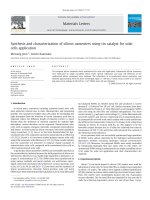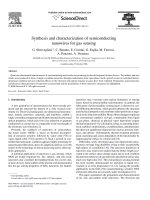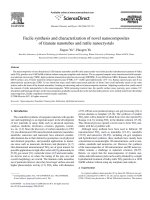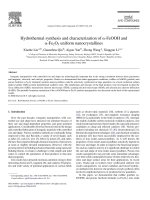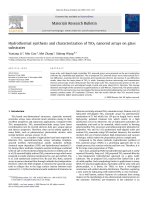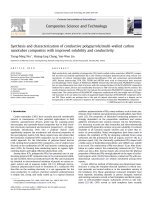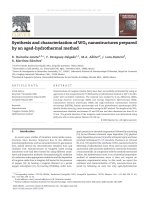- Trang chủ >>
- Khoa Học Tự Nhiên >>
- Vật lý
synthesis and characterization of novel ferromagnetic ppy-based nanocomposite
Bạn đang xem bản rút gọn của tài liệu. Xem và tải ngay bản đầy đủ của tài liệu tại đây (445.95 KB, 3 trang )
Synthesis and characterization of novel ferromagnetic PPy-based nanocomposite
Jing Jiang
a,
⁎
, Chaochao Chen
c
, Lun-Hong Ai
a
, Liang-Chao Li
b,
⁎
, Hui Liu
b
a
Laboratory of Applied Chemistry and Pollution Control Technology, College of Chemistry and Chemical Engineering, China West Normal University, Nanchong 637002, China
b
Department of Chemistry, Zhejiang Normal University, Jinhua 321004, China
c
Department of Property Management, China West Normal University, Nanchong 637002, China
abstractarticle info
Article history:
Received 4 October 2008
Accepted 18 November 2008
Available online 24 November 2008
Keywords:
Nanomaterials
Magnetic materials
Polypyrrole(PPy)
Magnetic property
Polypyrrole(PPy)/Zn
0.5
Cu
0.5
Fe
2
O
4
nanocomposite was prepared by a simple, general and inexpensive in situ
polymerization of pyrrole in the presence of Zn
0.5
Cu
0.5
Fe
2
O
4
nanoparticles in w/o microemulsion. The effects
of PPy coating on the magnetic properties of Zn
0.5
Cu
0.5
Fe
2
O
4
were investigated. By means of X-ray diffraction
(XRD), Fourier transform infrared (FTIR) spectra, scanning electron microscopy (SEM) and vibrating sample
magnetometer (VSM) technique, the microstructure and magnetic property of samples were characterized.
The SEM analysis indicated that PPy was deposited on the porous surface of Zn
0.5
Cu
0.5
Fe
2
O
4
. The results were
shown that the magnetic parameters such as saturation magnetization and coercivity of Zn
0.5
Cu
0.5
Fe
2
O
4
decreased upon PPy coating.
© 2008 Elsevier B.V. All rights reserved.
1. Introduction
Inherently conducting polymers are attractive materials, as they
cover a wide range of functions from insulators to metals and retain
the mechani cal prope rti e s of conventio na l polymer s [1,2].The
considerable electrochemical and physicochemical properties result
in conducting polymers having various practical applications, such as
corrosion protection coatings, electro-catalysts, chemical sensors,
rechargeable batteries, and light-emitting diodes (LEDs) [3–7].
Among the conducting polymer, polypyrrole (PPy) has received a
great deal of attention in recent years due to its easy synthesis, good
environmental stability, and high electrical conductivity [8].
Organic–inorganic nanocomposites with an organized structure
provide a new functional hybrid between organic and inorganic
materials. In recent years, conducting polymer-based composites
containing magnetic nanoparticles are of special interesting due to
their unique electromagnetic properties and potential applications in
several important technological fields such as electrochromic device,
electromagnetic interference shielding, and non-linear optical sys-
tems [9]. Up to the present, several groups have done much work on
synthesizing magnetic PPy-based nanocomposites. Deng et al. have
studied the synthesis of magnetic and conducting Fe
3
O
4
-polypyrrole
nanoparticles with core–shell structure by using sodium dodecylben-
zenesulfonate (NaDS) as a surfactant and dopant [10]. Wang et al. have
reported an ultrasonic irradiation approach to prepare polypyrrole
(PPY)/Fe
3
O
4
magnetic nanocomposite which can solve the problem in
the dispersion and stabilization of inorganic nanoparticles in polymer
[11].
Spinel magnetic ferrite has been intensively investigated due to
their remarkable magnetic and electrical properties and wide practical
applications in ferrofluids, magnetic drug delivery, magnetic high-
density information storage [12,13]. Therefore, it is very inter-
esting in preparing PPy composites containing magnetic ferrite
nanoparticles. To our best knowledge, spinel Zn
0.5
Cu
0.5
Fe
2
O
4
ferrite-
PPy nanocomposite system has not been reported yet. Herein, we
developed the water-in-oil (w/o) microemulsion process and first
prepared the PPy–Zn
0.5
Cu
0.5
Fe
2
O
4
nanocomposite with ferromagnetic
behavior. This approach provides a simple, general and inexpensive
method for the preparation of PPy–ferrite nanocomposite.
2. Experimental
Zn
0.5
Cu
0.5
Fe
2
O
4
nanoparticles were prepared by a citrate sol–gel
combustion process. The typical procedure was described in our
previous study [14]. The synthesis of PPy/Zn
0.5
Cu
0.5
Fe
2
O
4
nanocom-
posite was simply achieved via a microemulsion route. A quaternary
microemuls ion, Triton X-100/water/cyclohexane/ n-butanol was
selected for this study. In a typical procedure, 10 mL Triton X-100
was added to 5 mL 0.1 mol L
− 1
HCl solution, then 1 mL n-butanol and
50 mL cyclohexane were introduced. The mixture was stirred and the
system became transparent immediately; thus, a clear and transpar-
ent microemulsion system was obtained. A certain amount o f
Zn
0.5
Cu
0.5
Fe
2
O
4
particles were added into the homogeneous solution
and sonicated for 1 h. 1 mL pyrrole monomer was added to the
suspension and stirred for 30 min. 5 m L deionized water containing
3.51 g ammonium persulfate was then slowly added dropwise to the
Materials Letters 63 (2009) 560–562
⁎ Corresponding author. Tel.: +86 817 2568081; fax: +86 817 2582029.
E-mail address: (J. Jiang).
0167-577X/$ – see front matter © 2008 Elsevier B.V. All rights reserved.
doi:10.1016/j.matlet.2008.11.031
Contents lists available at ScienceDirect
Materials Letters
journal homepage: www.elsevier.com/locate/matlet
well-stirred reaction mixture. The reaction was carried out at 0 °C
under nitrogen while stirring for 8 h. The nanocomposite was
obtained by filtering and washing the suspension with methanol,
and dried under vacuum at 60 °C for 24 h.
The X-ray diffraction (XRD) patterns of the samples were collected
on a X-ray diffractometer with Cu Kα radiation. Infrared spectra were
recorded on a Brucker Equinox 55 FT-IR spectrometer in the range of
400–40 00 cm
− 1
using K Br pellets. The SEM micrographs were
obtained on a Hitachi S4800 scanning electron microscope. SEM
measurements were mounted on aluminum studs using adhesive
graphite tape and sputter coated with gold before analysis. Magnetic
measurements were carried out at room temperature using a
vibrating sample magnetometer (VSM) with a maximum magnetic
field of 10 kOe.
3. Results and discussions
The structures of the PPy/Zn
0.5
Cu
0.5
Fe
2
O
4
nanocomposite were
investigated by FTIR spectroscopy and X-ray diffraction. FTIR spectra of
the PPy and PPy/Zn
0.5
Cu
0.5
Fe
2
O
4
nanocomposite are shown in Fig. 1.
All characteristic peaks of PPy, the C=C backbone stretching at 1545 cm
− 1
,
C–C stretching modes at 1 463 cm
− 1
[15 ],C–Hin-planedeformation
vibrat ion at 1302 and 10 53 cm
− 1
,C–N stretching vibration at 1190 cm
− 1
,
the in-plane deformation vibration of NH
+
which is formed on the
PPy chains by protonation at 11 0 1 cm
− 1
[16],C–H out-of-plane ring de-
formation vibration at 795 cm
− 1
and the C–C out-of-plane ring defor-
mation vibration at 617 cm
− 1
canbeobserved.AsshowninFig. 1b, FTIR
spectra of PPy/Zn
0.5
Cu
0.5
Fe
2
O
4
nanocomposite are almost identical to that
of PPy. Due to the higher mass of the participating atoms, vibrations of
transitional metal–oxy gen bonds appear in the far-infrar ed region,
characteristic peaks of the ferritecannotbeexpectedinthepresent
spectral pattern [17].
Fig. 2 shows the XRD patterns of PPy/Zn
0.5
Cu
0.5
Fe
2
O
4
nanocompo-
site. It can be observed that the broad amorphous diffraction peak
centred at around 2θ = 23° in the XRD curves of PPy/Zn
0.5
Cu
0.5
Fe
2
O
4
Fig. 1. FTIR spectra of PPy (a) and PPy/Zn
0.5
Cu
0.5
Fe
2
O
4
nanocomposite (b).
Fig. 2. XRD patterns of PPy/Zn
0.5
Cu
0.5
Fe
2
O
4
nanocomposite (a) and the reference
standard data for Zn
0.5
Cu
0.5
Fe
2
O
4
of the JCPDS file No. 77-0012 (b).
Fig. 3. SEM micrographsof Zn
0.5
Cu
0.5
Fe
2
O
4
(a) and PPy/Zn
0.5
Cu
0.5
Fe
2
O
4
nanocomposite (b).
Fig. 4. Magnetization curves of Zn
0.5
Cu
0.5
Fe
2
O
4
(a) and PPy/Zn
0.5
Cu
0.5
Fe
2
O
4
nanocomposite
(b); the inset of the figure shows magnetization curves at low field.
561J. Jiang et al. / Materials Letters 63 (2009) 560–562
nanocomposite, corresponding to the scattering from bare polymer
chains at the interplanar spacing of protonated PPy [18], in addition,
another six diffraction peaks at 2θ = 30.1°, 35.4°, 43.1°, 53.5°, 57.0° and
62.6° assigned to scattering from (220), (311), (400), (422), (511) and
(440) planes of the spinel Zn
0.5
Cu
0.5
Fe
2
O
4
are consistent with the
reported data (JCPDS card No. 77-0012), which confirms the presence
of Zn
0.5
Cu
0.5
Fe
2
O
4
in the PPy/Zn
0.5
Cu
0.5
Fe
2
O
4
nanocomposite.
Fig. 3a shows the SEM micrograph of the as-burnt Zn
0.5
Cu
0.5
Fe
2
O
4
powders synthesized by a self-propagating combustion method,
indicating a characteristic of porous surface, formed by the escaping
gases during the combustion process [19]. Fig. 3b shows the SEM
micrograph of PPy/Zn
0.5
Cu
0.5
Fe
2
O
4
nanocomposite, suggesting that
PPy is deposited on the porous surface of Zn
0.5
Cu
0.5
Fe
2
O
4
.
Fig. 4 shows the magnetic hysteresis loops of Zn
0.5
Cu
0.5
Fe
2
O
4
and
PPy/Zn
0.5
Cu
0.5
Fe
2
O
4
nanocomposite at room temperature. It can be
observed that the saturation magnetization of PPy/Zn
0.5
Cu
0.5
Fe
2
O
4
nanocompos ite is lower t han th at of Zn
0.5
Cu
0.5
Fe
2
O
4
, due to
the diamagnetic PPy contribution to the total magnetization [20].
Magnetic properties observed for materials are a combination
of many anisotropy mechanisms, such a s magnetocrysta lline
anisotropy, surface anisotropy and interparticles interactions. For the
PPy/Zn
0.5
Cu
0.5
Fe
2
O
4
nanocomposite system, PPy coating may decrease
the surface anisotropy of Zn
0.5
Cu
0.5
Fe
2
O
4
and increase the interpar-
ticle distances which will lead to weakening interparticle interaction
[21,22], hence, the decrease in coercivity of Zn
0.5
Cu
0.5
Fe
2
O
4
after PPy
coating is expected. In order to investigate the effects of preparation
route on the magnetic properties of PPy/Zn
0.5
Cu
0.5
Fe
2
O
4
nanocompo-
site, a contrast experiment was carried out in aqueous solution. The
resulted sample also shows the magnetic hysteretic behavior and a
similar value of saturation magnetization, however, the coercivity,
which is related to the microstructure, is larger than that of the
sample obtained by w/o microemulsion route (Table 1), indicating that
Zn
0.5
Cu
0.5
Fe
2
O
4
nanoparticles are more homogeneously embedded in
PPy matrix by w/o microemulsion route.
4. Conclusions
In summary, the ferromagnetic PPy/Zn
0.5
Cu
0.5
Fe
2
O
4
nanocompo-
site was successfully synthesized via in-situ polymerization of pyrrole
in the presence of Zn
0.5
Cu
0.5
Fe
2
O
4
nanoparticles inw/omicroemulsion.
Zn
0.5
Cu
0.5
Fe
2
O
4
nanoparticles were obtained by a citrate sol–gel
combustion method. It was shown that the saturation magnetization
and coercivity of Zn
0.5
Cu
0.5
Fe
2
O
4
nanoparticles decreased upon PPy
coating, which can be attributed to the diamagnetic PPy contribution
to the magnetic properties.
Acknowledgement
This work was supported by Scientific Research Start-up Founda-
tion of China West Normal University (07B008).
References
[1] Kang ET, Neoh KG, Tan KL. Prog Polym Sci 1998;23:277–324.
[2] Heeger AJ. Synth Met 2002;125:23–42.
[3] Ahmad N, MacDiarmid AG. Synth Met 1996;78:103–10.
[4] Ficicoglu F, Kadirgan F. J Electroanal Chem 1998;451:95–9.
[5] Kan JQ, Pan XH, Chen C. Biosens Bioelectron 2004;19:1635–40.
[6] Kuwabata S, Masui S, Yoneyama H. Electrochim Acta 1999;44:4593–600.
[7] Wang HL, MacDiarmid AG, Wang YZ, Gebler DD, Epstein AJ. Synth Met 1996;78:33–7.
[8] Skotheim TA, Elsenbaumer R, Reynolds JR. Handbook of Conducting Polymers.
New York: Marcel Dekker; 1998.
[9] Alam J, Riaz U, Ahmad S. J Magn Magn Mater 2007;314:93–9.
[10] Deng J, Peng Y, He C, Long X, Li P, Chan ASC. Polym Int 2003;52:1182–7.
[11] Qiu G, Wang Q, Nie M. Macromol Mater Eng 2006;291:68–74.
[12] Pileni MP. Adv Funct Mater 2001;5:323–36.
[13] Song Q, Zhang ZJ. J Am Chem Soc 2004;126:6164–8.
[14] Jiang J, Ai LH. Appl Phys A 2008;92:341–4.
[15] He C, Yang C, Li Y. Synth Met 2003;139:539–45.
[16] Blinova NV, Stejskal J, Trchová M, Prokeš J, Omastová M. Eur Polym J 2007;43:2331–41 .
[17] Jiang J, Li L, Zhu M. React Funct Polym 2008;68:57–62.
[18] Seo I, Pyo M, Cho G. Langmuir 2002;18:7253–7.
[19] Xue H, Li Z, Wang X, Fu X. Mater Lett 2007;61:347–50.
[20] Xu P, Han X, Wang C, Zhao H, Wang J, Wang X, et al. J Phys Chem B 2008;112:2775–81.
[21] Vestal CR, Zhang ZJ. J Am Chem Soc 2002;124:14312–3.
[22] Vestal CR, Zhang ZJ. Nano Lett 2003;3:1739–43.
Table 1
Magnetic parameters of PPy/Zn
0.5
Cu
0.5
Fe
2
O
4
nanocomposite synthesized by different r oute
Preparation route Saturation magnetization (emu/g) Coercivity (Oe)
W/o microemulsion route 1.56 20.9
Aqueous solution process 1.49 28.2
562 J. Jiang et al. / Materials Letters 63 (2009) 560–562
